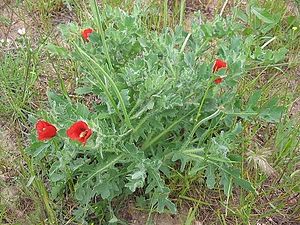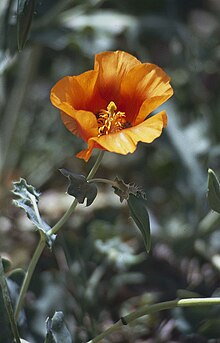Horn poppy
| Horn poppy | ||||||||||||
|---|---|---|---|---|---|---|---|---|---|---|---|---|

Red horned poppy ( Glaucium corniculatum ) |
||||||||||||
| Systematics | ||||||||||||
|
||||||||||||
| Scientific name | ||||||||||||
| Glaucium | ||||||||||||
| Mill. |
Horn poppy ( Glaucium ) is a genus of plants in the subfamily Papaveroideae within the poppy family (Papaveraceae). The 20 to 25 species are common in North America, Europe, and central and southwest Asia.
description
Vegetative characteristics
Glaucium species are annual, biennial or perennial herbaceous plants . The alternate leaves are mostly lobed. A typical feature of the genus Glaucium is the blue-green coloration of stems and leaves. The plants contain yellow milky sap . There are no stipules.
Generative characteristics
The flowers are solitary or grouped in zymose or racemose inflorescences . They have hermaphroditic, radially symmetrical flowers divided into calyx and crown . The two sepals cover the petals for protection when they are budding and fall off when the flowers are opened. Open flowers seem to have only one petal circle. There are four petals . In each flower there are many (50 to 100) free stamens that are formed centripetally. Two carpels have become a top permanent ovary grown. Pollination occurs by insects ( entomophilia ).
The capsule fruits open with two flaps from the top to almost the base and contain many dark brown seeds; they are mostly cylindrical, with Glaucium flavum horn-shaped.
Systematics and distribution
The genus Glaucium was established by Philip Miller in 1754 . The botanical genus name Glaucium is derived from the Latin word glaucus for blue-green and refers to the coloring of the vegetative parts of the plant.



There are 20 to 25 Glaucium TYPES (selection):
- Glaucium acutidentatum Hausskn. & Bornm. : It occurs in Turkey .
- Glaucium aleppicum Boiss. & Hausskn. : It occurs from Jordan to Syria .
- Glaucium arabicum Fresen. : It occurs in Saudi Arabia , Egypt , the Sinai Peninsula , Israel and Jordan .
- Glaucium cappadocicum Boiss. : It occurs in Turkey.
- Glaucium caricum Stapf : It occurs in Turkey.
- Red horned poppy ( Glaucium corniculatum (L.) Rudolph ): It is widespread from Europe and North Africa to Western Asia and Central Asia .
- Glaucium elegans fish. & Mey. : The home is Afghanistan , Iran and Pakistan .
- Glaucium fimbrilligerum (Trautv.) Boiss. : The homeland is Iran, Turkestan , Afghanistan and Pakistan.
- Yellow horn poppy ( Glaucium flavum Crantz ): It is widespread in Europe, North Africa and the Middle East.
- Large-flowered horn poppy ( Glaucium grandiflorum Boiss. & A. Huet ): Its home is Turkey and Iran.
- Glaucium haussknechtii Fedde : It occurs in Turkey.
- Glaucium oxylobum Boiss. & Buhse : It occurs in Turkey, Syria, Cyprus and Bulgaria .
- Altai horn poppy ( Glaucium squamigerum Kar. & Kir. ): It occurs in the Central Asian Altai and Chinese Xinjiang .
use
In ancient medicine, horn poppy was used in ointments e.g. B. used to treat eye diseases.
literature
- Dankwart Seidel: Flowers on the Mediterranean. Determine accurately with the 3-check . BLV, Munich 2002, ISBN 3-405-16294-7 .
- Manfred A. Fischer, Wolfgang Adler, Karl Oswald: Excursion flora for Austria, Liechtenstein and South Tyrol . 2nd, improved and enlarged edition. State of Upper Austria, Biology Center of the Upper Austrian State Museums, Linz 2005, ISBN 3-85474-140-5 .
- Robert W. Kiger: Glaucium. In: Flora of North America Editorial Committee (Ed.): Flora of North America North of Mexico . Volume 3: Magnoliophyta: Magnoliidae and Hamamelidae . Oxford University Press, New York / Oxford a. a. 1997, ISBN 0-19-511246-6 (English). ( online at efloras.org )
- SMH Jafri, M. Qaiser: Glaucium at Tropicos.org. In: Flora of Pakistan . Missouri Botanical Garden, St. Louis, pp. 2-3, In: Flora of West Pakistan Volume 61: Papaveraceae . Stewart Herbarium, Gordon College, Rawalpindi 1974
Individual evidence
- ↑ a b c d e f Mariam V. Aghababian: Papaveroideae. : Data sheet - Glaucium In: Euro + Med Plantbase - the information resource for Euro-Mediterranean plant diversity. Berlin 2011.
- ^ Glaucium in the Germplasm Resources Information Network (GRIN), USDA , ARS , National Genetic Resources Program. National Germplasm Resources Laboratory, Beltsville, Maryland. Retrieved May 21, 2015.
- ↑ Walter Erhardt , Erich Götz, Nils Bödeker, Siegmund Seybold: The great zander. Encyclopedia of Plant Names. Volume 2. Types and varieties. Eugen Ulmer, Stuttgart (Hohenheim) 2008, ISBN 978-3-8001-5406-7 .
- ↑ Fabian Reiter: Medical recipes on a Heidelberg papyrus. In: Files from the 21st International Papyrology Congress , Berlin 1995, Archive for Papyrus Research, Supplement 3, 1997, pp. 804–826